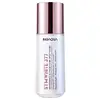What's inside
What's inside
 Key Ingredients
Key Ingredients

 Benefits
Benefits

 Concerns
Concerns

 Ingredients Side-by-side
Ingredients Side-by-side

Water
Skin ConditioningDisodium Laureth Sulfosuccinate
CleansingCocamidopropyl Betaine
CleansingPropanediol
SolventGlycerin
HumectantAloe Barbadensis Leaf Extract
EmollientHamamelis Virginiana Leaf Extract
Skin ConditioningPolyacrylate Crosspolymer-6
Emulsion StabilisingAlcohol
AntimicrobialCitrus Limon Fruit Extract
MaskingChlorphenesin
AntimicrobialSalicylic Acid
MaskingRheum Palmatum Root Extract
AstringentAllantoin
Skin ConditioningHoney
HumectantPortulaca Oleracea Extract
Skin ConditioningParfum
MaskingCitric Acid
BufferingWater, Disodium Laureth Sulfosuccinate, Cocamidopropyl Betaine, Propanediol, Glycerin, Aloe Barbadensis Leaf Extract, Hamamelis Virginiana Leaf Extract, Polyacrylate Crosspolymer-6, Alcohol, Citrus Limon Fruit Extract, Chlorphenesin, Salicylic Acid, Rheum Palmatum Root Extract, Allantoin, Honey, Portulaca Oleracea Extract, Parfum, Citric Acid
Water
Skin ConditioningNiacinamide
SmoothingPropylene Glycol
HumectantSorbitol
HumectantErythritol
HumectantPhenylethyl Resorcinol
AntioxidantCarbomer
Emulsion StabilisingHydroxyacetophenone
AntioxidantCentella Asiatica Extract
CleansingCaprylhydroxamic Acid
Ethylhexylglycerin
Skin ConditioningPEG-40 Hydrogenated Castor Oil
EmulsifyingPotassium Hydroxide
BufferingGlyceryl Caprylate
EmollientTranexamic Acid
AstringentHydrolyzed Rhodophyceae Extract
Dextran
Sophora Flavescens Root Extract
AntioxidantPortulaca Oleracea Extract
Skin ConditioningMica
Cosmetic ColorantCeramide Ns
Skin ConditioningCeramide NP
Skin ConditioningCeramide Ng
Skin ConditioningCeramide Eos
Skin ConditioningCeramide EOP
Skin ConditioningCeramide As
Skin ConditioningCeramide AP
Skin ConditioningHexapeptide-8
Skin ConditioningOligopeptide-1
Skin ConditioningCarnosine
Skin ConditioningHydrolyzed Hyaluronic Acid
HumectantHyaluronic Acid
HumectantSodium Hyaluronate
HumectantBifida Ferment Filtrate
Skin ConditioningWater, Niacinamide, Propylene Glycol, Sorbitol, Erythritol, Phenylethyl Resorcinol, Carbomer, Hydroxyacetophenone, Centella Asiatica Extract, Caprylhydroxamic Acid, Ethylhexylglycerin, PEG-40 Hydrogenated Castor Oil, Potassium Hydroxide, Glyceryl Caprylate, Tranexamic Acid, Hydrolyzed Rhodophyceae Extract, Dextran, Sophora Flavescens Root Extract, Portulaca Oleracea Extract, Mica, Ceramide Ns, Ceramide NP, Ceramide Ng, Ceramide Eos, Ceramide EOP, Ceramide As, Ceramide AP, Hexapeptide-8, Oligopeptide-1, Carnosine, Hydrolyzed Hyaluronic Acid, Hyaluronic Acid, Sodium Hyaluronate, Bifida Ferment Filtrate
Ingredients Explained
These ingredients are found in both products.
Ingredients higher up in an ingredient list are typically present in a larger amount.
This extract comes from Purslane, a succulent. It has anti-inflammatory, antioxidant, and hydrating properties.
Purslane is very nutritious. It contains omega-3 fatty acids, NMFs, many vitamins, minerals, and antioxidants. The vitamins found in purslane include: Vitamin C, Vitamin A, and Vitamin E.
Fun fact: Purslane is a succulent with an extensive habitat. It is used in traditional Korean medicine to treat irritated skin.
Nowadays, purslane is becoming a superfood due to its highly nutritious content.
Learn more about Portulaca Oleracea ExtractWater. It's the most common cosmetic ingredient of all. You'll usually see it at the top of ingredient lists, meaning that it makes up the largest part of the product.
So why is it so popular? Water most often acts as a solvent - this means that it helps dissolve other ingredients into the formulation.
You'll also recognize water as that liquid we all need to stay alive. If you see this, drink a glass of water. Stay hydrated!
Learn more about Water